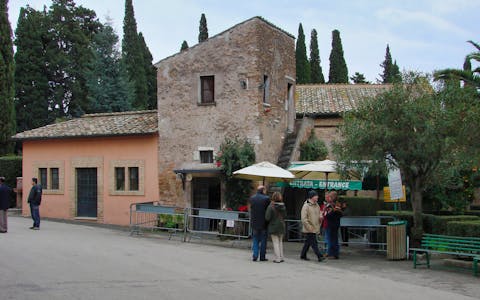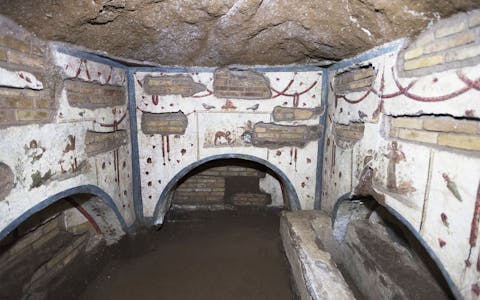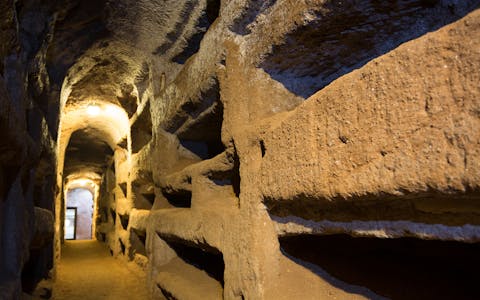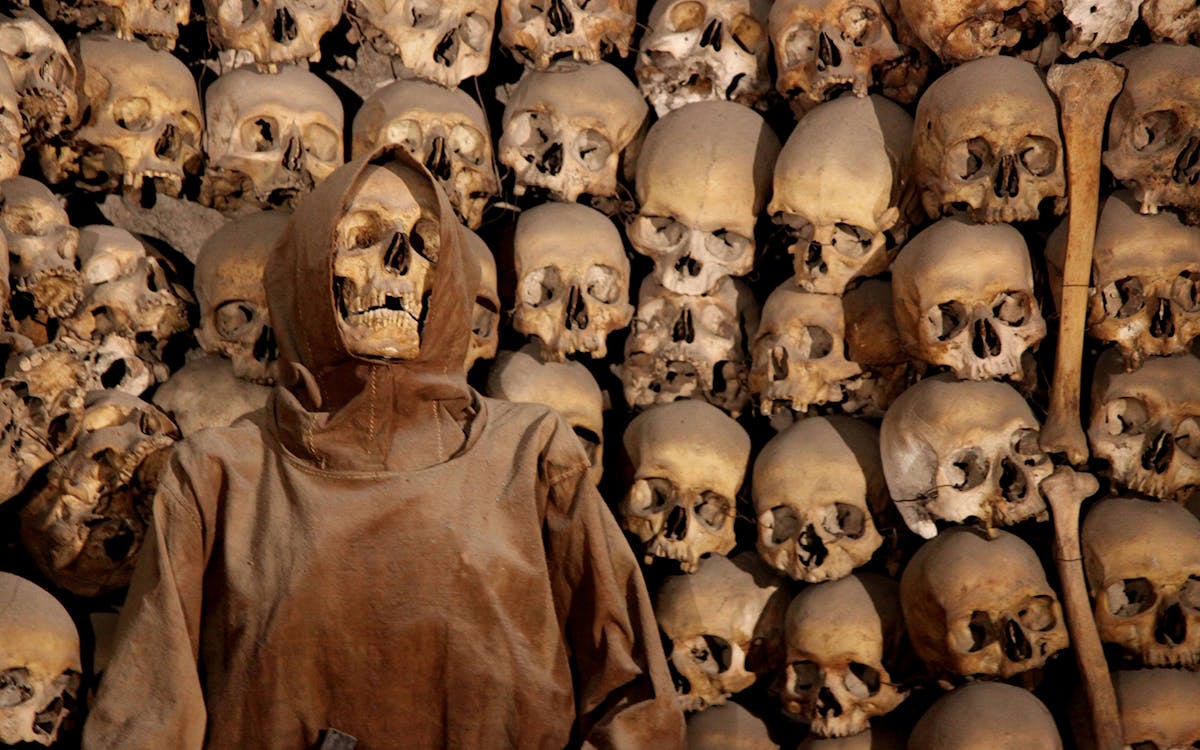Rome is one of the oldest cities in the world, where history was made, and legends were born. Under this sprawling city is a network of tunnels where the long dead whisper tales of yore. With skeletons and dark narrow alleys, these tunnels are the Catacombs, where the early Christians buried their dead. Today, through a Roman Catacombs tour, we can peek into the past, a period between the 2nd-4th centuries when Rome was transitioning from a Pagan religion to Christianity.
The Roman Catacombs display architectural brilliance; they are carved out volcanic rock, are built for miles at stretch, and lie several feet deep into the ground. The Catacombs are an irreplaceable part of Roman history, revealing early Christian art in the form of frescoes and sculpture. Any traveler seeking to understand the foundation of Rome and Christianity must visit the Roman Catacombs!

Roman Catacombs - In A Nutshell
Handy information
| ⏰ Suggested Duration: | 1-2 hours |
| ☀️ Best Time to Visit: | Early Morning |
| 💜 Must See: | Santa Maria della Concezione dei Cappuccini |
| 🎟️ Guided Tour | €69 |
Must-see
Capuchin Crypt
Basilica San Martino Ai Monti
Catacombs of St. Callixtus
Catacombs of Domitilla
Why You Should Visit the Roman Catacombs
- Historical Significance: The Roman Catacombs are a remarkable testament to the ancient Roman civilization. They provide a unique glimpse into the past, offering a rich historical experience unlike any other.
- Religious Importance: Many catacombs served as burial grounds for early Christians, making them significant pilgrimage sites for those interested in Christian history.
- Mystical Atmosphere: Venturing into the catacombs creates a unique and eerie ambiance. The dimly lit tunnels and underground chambers evoke a sense of mystery, transporting visitors to a different world.
- Uncover Hidden Gems: Some catacombs are less well-known and less visited than others. Venturing off the beaten path can lead to discovering lesser-known catacombs, offering a more personal and exclusive experience.
- Artistic Splendor: The catacombs are adorned with beautiful frescoes, sculptures, and inscriptions. These artworks provide an artistic narrative of the period, displaying the skills and creativity of the ancient Roman artisans.
Roman Catacombs Tour Tickets
History of the Roman Catacombs
The history of the Roman Catacombs dates back to the 2nd century AD. As the Roman Empire expanded, burial within the city walls became prohibited. Consequently, the Romans began constructing elaborate underground burial sites outside the city limits. These catacombs served as resting places for early Christians, as well as for members of the Jewish community. The catacombs expanded over time, creating a vast network of tunnels, chambers, and tombs. They were places of religious significance and provided a clandestine meeting place for early Christians during times of persecution. Today, the Roman Catacombs stand as a testament to ancient Roman civilization and offer a captivating journey into the past.
Roman Catacombs Tours Explained
1Roman Basilicas & Underground Catacombs on the Appian Way
Accompanied by an expert guide, you'll begin by visiting the Holy Staircase — a revered sequence of 28 marble steps, believed to have been walked on by Jesus. Next, behold the architectural splendor of the Basilica of St. John Lateran, adorned with exquisite sculptures. The itinerary further includes a visit to St. Mary Major Church, followed by a journey along the historic Appian Way. Conclude your tour with an exploration of the underground catacombs, meandering through their labyrinthine corridors that once served as burial grounds.

2Underground Catacombs with Panoramic Bus Transfers
Embark on a VIP Tour of Rome's intriguing and extraordinary sites. Enjoy a transfer from the city center to the Saint Callixtus Catacombs on a panoramic bus. Explore the mesmerizing network of tunnels, adorned with rock-carved tombs. Delve into captivating stories about the history of these sacred places during a guided tour available in your preferred language. Prepare for an unforgettable experience, as the baffling and outlandish allure of the catacombs leaves an indelible impression.

3Crypts & Catacombs and Legends & Ghosts of Rome Tour
Go on an ancient ghost tour, starting in the 2nd-century Roman Catacombs. These eerie tunnels were once hiding places for early Christians, who sought refuge for their forbidden faith. The tour then takes you to the seldom-visited 12th-century Basilica San Clemente. Journey through a 5th-century church, a 4th-century cult temple, and descend to the original 1st-century street level, where the ancient aqueduct haunted the troubled priest. After this, head to the Capuchin Crypt, known as the 'Bone Chapel,' where more than 4,000 monk skeletons create a chilling display.

4Catacombs of St. Callixtus
Explore the hidden realm of the ancient Roman underworld on a guided tour of St. Callixtus Catacomb. Dating back to the 2nd century, these galleries served as burial grounds for the Romans. Uncover the unique history of these ancient cemeteries with a knowledgeable guide. St. Callixtus Catacomb, the largest burial site in the Roman Catacombs, was rediscovered in 1854. Discover captivating myths, legends, and historical tales as you wander through the labyrinthine tunnels. Marvel at intricate art such as frescoes, inscriptions, and sarcophagi. Visit the final resting places of popes, martyrs, and notable figures in this captivating yet dark side of the Eternal City.

5Roman Catacombs, Basilica San Martino Ai Monti & Capuchin Crypts
Explore the mysterious Christian Catacombs, adorned with frescoes, iconography, and burial sites adorned with skeletal remains. Marvel at the exquisite Gagliardi frescoes and ancient Corinthian columns and aisles at the Basilica San Martino Ai Monti. Finally, be astounded by the Capuchin Bone Crypt, adorned with the skeletal remains of more than 4,000 friars, creating a truly captivating sight.

Interesting Facts About the Roman Catacombs

- The word catacomb has been derived from the Greek word ‘coemeterium’ meaning dormitory. It refers to the Christian belief that burial is only temporary, till the soul can be resurrected again.
- A recent restoration of the frescoes of the Catacombs of Domitilla was undertaken. Layers of grime from lamp soot, oil and calcium deposits were drilled through laser techniques to reveal beautiful and vivid frescoes including the ‘Room of the Bakers’.
- The Roman Catacombs are the place where Pagan religion meets Christianity, and this can be seen in the artwork throughout the Catacombs. Some of the frescoes include Pagan symbols like doves and then the fish came along with the early signs of Christianity. Then came the elaborate detailed frescoes of Last Supper, Moses and other biblical depictions.
- The Roman Catacombs are named after the Christian martyrs who were buried there like Marcellinus and Peter, Saints like Saint Valentine (San Valentino) Saint Sebastian (San Sebastino), or after the owners of the land under the catacombs like Santa Priscilla.
- The Roman Catacombs are not tourist places, but places of religion and are thus maintained by the papacy at Vatican. The Pontifical Commission of Sacred Archaeology takes up the maintenance and responsibility of the Catacombs and assigns it to various orders of nuns and priests to take care of them.
Roman Catacombs Insider Tips
- The Roman Catacombs are built under Churches and are Christian burial grounds, making them sacred places. Ensure you are dressed appropriately and cover your shoulders and knees.
- The catacombs are narrow alleys and stretch deep into the earth and for long distances, while they are adequately lit, it can get claustrophobic. If you are prone to anxiety in such places, avoid it altogether.
- Carry a bottle of water and snacks for the tour. There aren’t many places to eat near the catacombs.
- Wear comfortable walking shoes, the tunnels are hand hewn and do not have flat surfaces throughout.
FAQs: Roman Catacombs
The Catacombs of Rome are former underground burial grounds that date from the second to the fifth century and were principally used by Christians and Jews. The catacombs are subterranean passageways that were used as place of burial for a number of centuries.
For this reason all the catacombs were located outside the walls of the city. These places were a shelter apart and hidden underground where Christians could burial their own, using freely Christian symbols.
The catacombs are an amazing opportunity to learn about parts of the city's history you might not otherwise come across. Popes were buried in the Roman catacombs, and early Christians took tables and benches down to the tunnels as the religion outgrew home-worship. Rome's catacombs are some of the oldest in the world.
The Paris Catacombs is home to an estimated 7 million skeletons and they are very visible today. In Rome, you may see a skeleton under glass but most of the tombs had been cleared out a long time ago
At first, the catacombs were merely burial places; places where Christians could meet to perform funeral rites and celebrate the anniversaries of the martyrs and the dead. During the persecutions for the third century, Christians used the catacombs as places of momentary refuge for the celebration of the Eucharist.
They were not hideouts, they were not places where Christians were hiding. They were quite public, where everyone was being buried of this class. So, Christians were being buried in the catacombs.
The temperature underground in the Catacombs is about 57° F (14° C), much cooler than Paris in summer.
Find out what the dress code is before you go on a Catacombs of Rome tour. For example, tourists entering the Vatican Necropolis and St Peter's Basilica must have covered shoulders. In addition, men should wear long pants and women long pants or dresses the reach below the knee.


